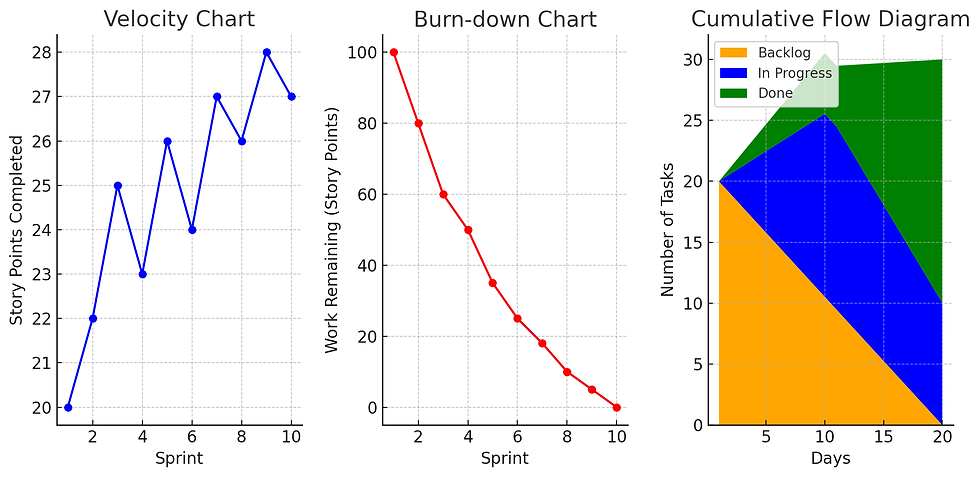Agile Software Development Metrics: From Basics to Advanced Insights
- Filip Cel

- Aug 8, 2024
- 3 min read
In the software development industry, metrics play a crucial role in helping teams and organizations measure progress, identify bottlenecks, and continuously improve their processes. This blog explore both basic and advanced Agile metrics, explaining how to use them and what insights they can provide.
Basic Agile Metrics
1. Velocity
What it is: Velocity measures the amount of work a team completes in a single sprint.
How to use it: Track the number of story points or user stories completed in each sprint.
What it shows: Velocity helps in sprint planning and estimating how much work a team can commit to in future sprints.
2. Sprint Burndown
What it is: A visual representation of work completed versus work remaining in a sprint.
How to use it: Update daily, plotting remaining work against ideal burndown.
What it shows: Helps the team understand if they're on track to complete the Sprint plan.
3. Cycle Time
What it is: The time it takes for a work item to move through the team's workflow, from start to finish.
How to use it: Measure the time between when work begins on an item and when it's completed.
What it shows: Identifies bottlenecks in the development process and helps improve efficiency.
Advanced Agile Metrics
1. Cumulative Flow Diagram (CFD)
What it is: A stacked area chart showing the number of work items in each state of the development process over time.
How to use it: Track the number of items in each workflow state (e.g., To Do, In Progress, Done) daily.
What it shows: Visualizes workflow efficiency, identifies bottlenecks, and shows how work is accumulating in different stages.
2. Lead Time
What it is: The total time from when a request is made (for example creation of an epic or a user story) to when it's delivered.
How to use it: Measure the time between when a backlog item is created and when it's deployed to production.
What it shows: Helps understand the overall efficiency of the development process and can be used to set expectations with stakeholders.
3. Code Coverage
What it is: The percentage of code covered by automated tests.
How to use it: Use code coverage tools to measure the proportion of your codebase that is exercised by tests.
What it shows: Indicates the thoroughness of testing efforts and potential areas of risk in the codebase.
4. Escaped Defects
What it is: The number of bugs found in production that were not caught during the development process.
How to use it: Track and categorize bugs found after release.
What it shows: Helps evaluate the effectiveness of quality assurance processes and identifies areas for improvement in testing.
Using Agile Metrics Effectively
How to approach using metrics and what should be our core principles?
Context Matters: Always consider the context when analyzing metrics. For example, a temporary drop in velocity might be due to team members taking time off, rather than a systemic issue.
Choose metrics wisely: Select metrics that align with your team's goals and provide actionable insights.
Focus on trends: Individual data points are less important than patterns over time
Iterate and Improve: Use metrics as a feedback loop. Regularly review them in retrospectives to identify areas for improvement and make necessary adjustments.
Avoid Metric Obsession: Metrics are a tool, not an end in themselves. Avoid focusing too much on any single metric. Instead, use a balanced set of metrics to get a comprehensive view of the team’s performance.
Agile metrics, when used correctly, can provide valuable insights into your development process, team performance, and areas for improvement. By understanding both basic and advanced metrics, teams can make data-driven decisions to enhance their Agile practices and deliver better software more efficiently.
Remember, metrics are tools to gain insights, not goals in themselves. Always interpret metrics in the context of your team's unique situation and use them to foster continuous improvement rather than as a means of judgment or comparison between teams.






Comments